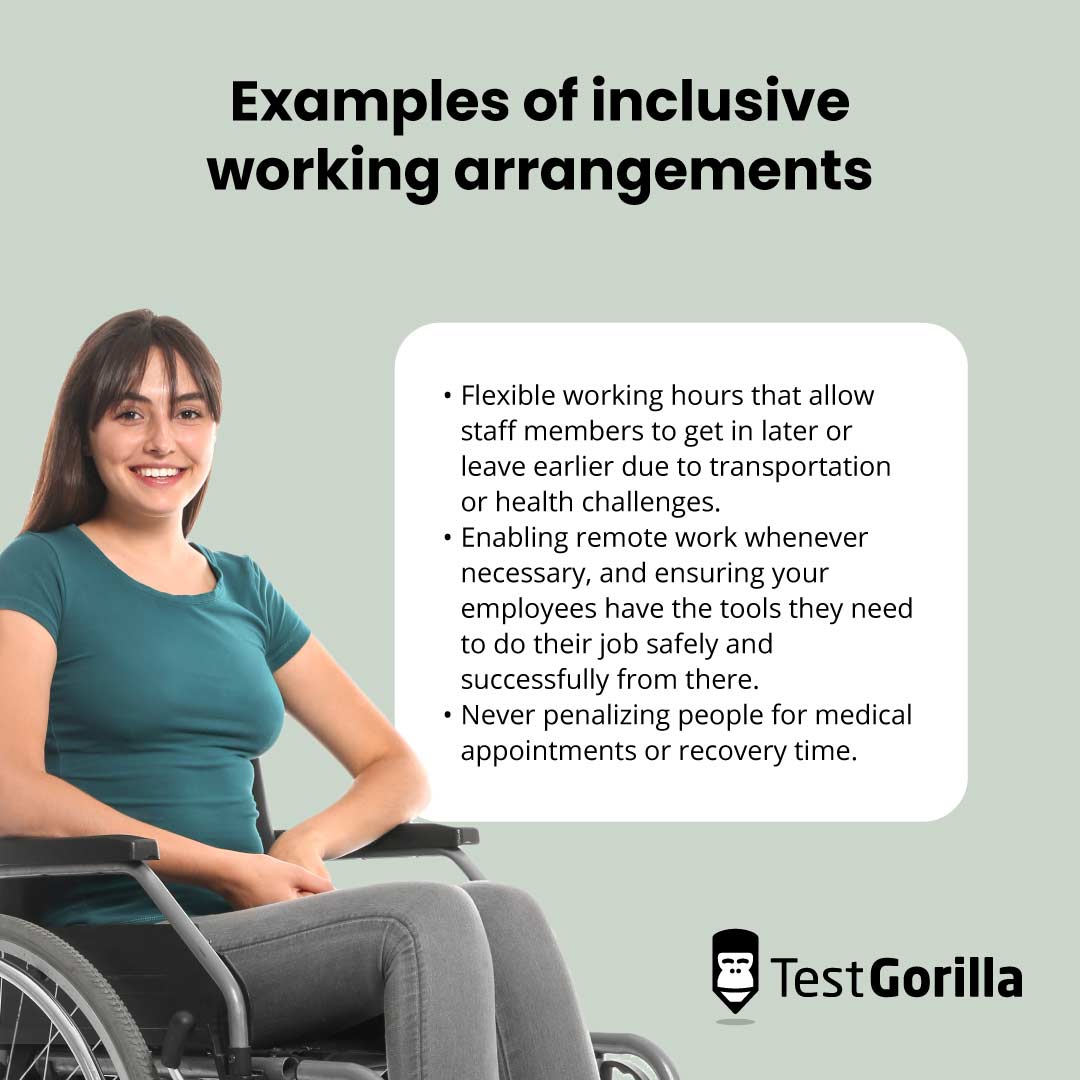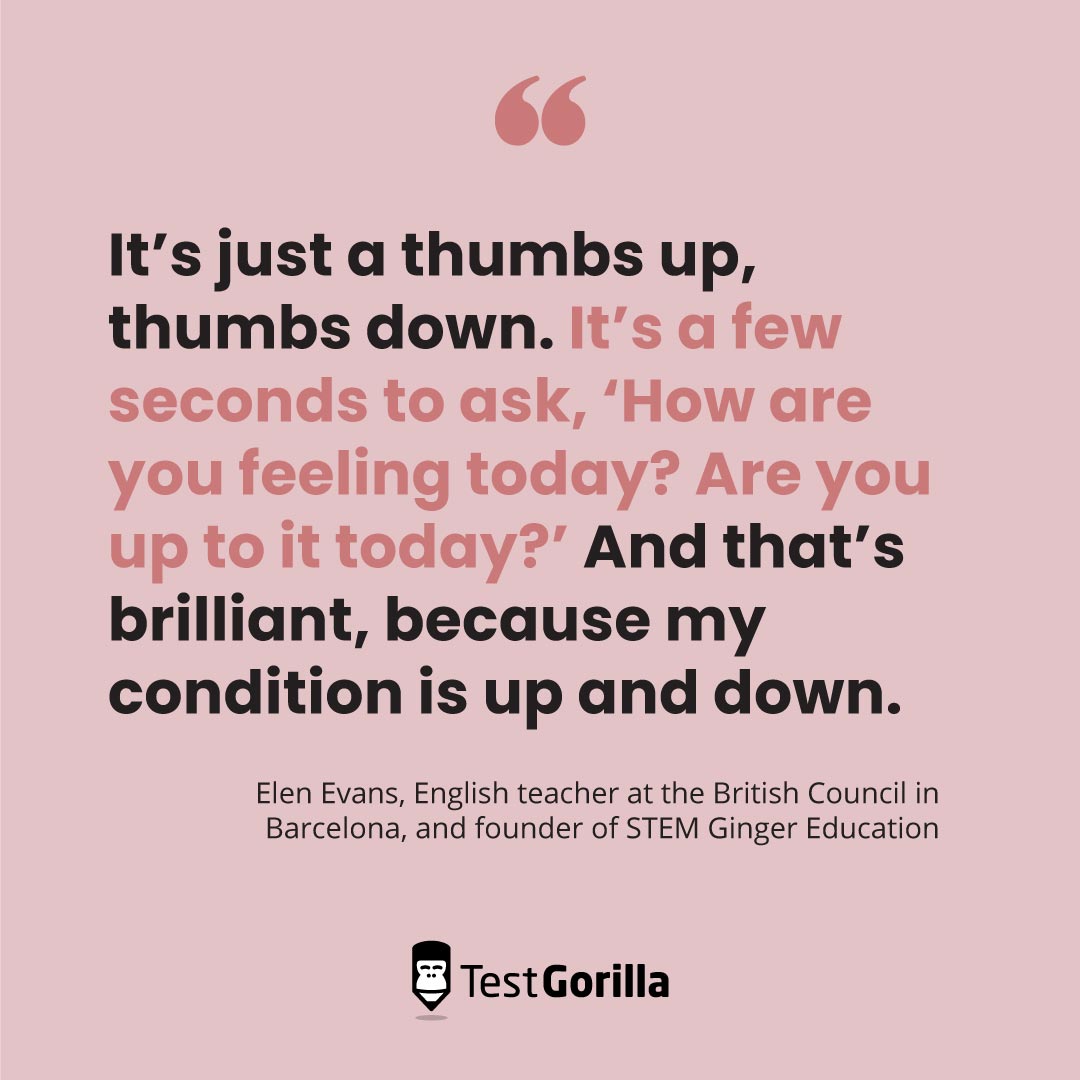People with disabilities make up 26% of the American population, yet they face very low employment rates compared to those without a disability.[1][2]
Unconscious bias during recruitment and a lack of accessible workplaces both play a part in this, with the result that companies miss out on talent, and would-be employees miss out on great jobs.
Research suggests that by accommodating adults with disabilities, companies could add nearly $215bn to US GDP by 2040.[2]
By creating a workplace that’s inclusive to people with disabilities, you can ensure fairness, respect, and equal treatment and create a positive culture where workers – no matter their disability – can succeed.
In this piece, we examine the disability employment gap and the benefits of hiring people with disabilities. We then explore how to attract and recruit workers with disabilities, and how to accommodate them in your company.
We also look at how you can use skills-based hiring to simplify your hiring practices, reduce unconscious bias, and get the best talent for your team.
Table of contents
✅ Accommodating adults with disabilities: A win-win for your workplace
The disability employment gap
Making your workplace attractive and offering special accommodations to people with disabilities can help you recruit the best talent for a role.
However, many companies don’t manage it.
The latest Women in the Workplace study from McKinsey and mentorship group LeanIn.org found that almost a quarter of women with disabilities said their disability has led to them missing out on a raise, promotion, or chance to get ahead.
It also found that women with disabilities were more likely than other employees to face microaggressions, like having their competence questioned. At the same time, 25% said their company prioritizes disability in its diversity and inclusion efforts.
Elen Evans, an English teacher in Barcelona, has had this experience in her career. As a woman with multiple sclerosis (and officially recognized as disabled in Spain), she explained that she once interviewed for a job in a school.
Although the company positioned itself as “inclusive,” and the hiring manager said Elen “was exactly what we’re looking for,” Elen wasn’t offered the job because it would involve playing games with the children and going from one place to another, which the manager didn’t think she’d be able to do.
“I was upset and angry,” Elen says. “They said they were inclusive and reached out to people with disabilities. But would they employ us? No.”
Just as Elen found, many people with disabilities discover that workplaces don’t adapt to them.
In fact, an October 2022 OECD report found that “policy efforts in the past two decades have not gone far enough, despite good intentions” to improve the number of disabled people in employment. It concluded that institutions “must understand the importance of disability inclusion” and “include people with disability in their programs and approaches.”
Let’s take a look at how you can get beyond good intentions and include people with disabilities in your D&I strategy.
3 ways to attract and recruit workers with disabilities
By attracting and recruiting workers with disabilities, you help to close the disability employment gap – and gain access to a wide group of top talent. Here’s how:
1. Start with your D&I policy
Making your workplace more welcoming to people with disabilities is about baking that intention into your diversity and inclusion policy from the start.
Establish the inclusion of people with disabilities as one of your values, so your commitment to welcoming people with disabilities is reflected throughout your organization.
This could include:
Making sure it’s visible and well-communicated to each newly-onboarded staff member – whether they have a disability or not.
Adding it to every communication or training you do on the subject of your values.
Planning regular training exercises to educate your team on what respect for disability inclusion looks like in practice.
This will ensure that every member of staff sees it as a key priority, that every meeting, initiative, and event is accessible, and that your workplace embodies and builds on the tips and approaches we’ve listed below.
2. Create an inclusive recruitment funnel
Attracting talented people with disabilities means making the applicant experience easier throughout their hiring journey – and reducing unconscious biases among your hiring managers.
This can include:
Stating that you welcome people with disabilities, and do not discriminate.
Showing people with disabilities in your recruitment and marketing imagery.
Featuring quotes and stories of real people with disabilities in your organization online.
Providing application details in a variety of formats (such as digitally, in Braille, or in large print).
Asking applicants if they need any extra help to complete the application process and making it clear that needing extra help will not be counted against them in any way.
Letting them know that your workplace is wheelchair accessible.
Referring to people with disabilities sensitively, for example, saying “people with disabilities” rather than “disabled.” Different people may prefer different terms, so be sure to ask (See more on this below.)
You could also reach out to disability advocate networks and organizations, colleges, and schools, and make it clear that your workplace is open to a wide range of applicants, including those with disabilities.
Putting your name out there and being intentional in recruiting people with disabilities will highlight your company as a pioneer in the field and help you to attract top talent.
Attracting people with disabilities ensures you don’t miss out on top talent. Discover more on how a diverse workforce can transform your business.
3. Use skills-based hiring
Hiring based on skills is a powerful way to sidestep accidental disability biases or discrimination. It makes it easier to highlight the best candidates and ensure they’re qualified for the job – before any accessibility needs are considered.
This means you put your anti-bias principles into practice, as well as hire the best person for the job, leaving you free to help them access your workplace with confidence.
Our 2022 report shows that using skills-based hiring through a platform like TestGorilla can improve your organization’s diversity by more than 91%.
Using a testing platform like TestGorilla, with our library of hundreds of tests, lets you check for specific skills as well as for personality and values, so you can get to know the person without unconscious biases getting in the way.
You can also make special accommodations during the talent assessment process to ensure you give workers with disabilities an experience that suits their needs.
Discover how skills-based hiring helps you overcome biases. Read our piece on how skills-based hiring levels the playing field here.
7 ways to accommodate adults with disabilities
Recruiting people with disabilities is one thing. Making them feel genuinely welcome and enabling them to do their job to the best of their abilities is another.
A key takeaway here is to never assume that you understand an employee’s disability and what accommodations they need. Instead, ask how you can help and for ideas on the support you can offer.
1. Offer flexible working hours and location
During the pandemic, hybrid and remote policies became widespread, and many companies and workers find they still make sense now. This is especially true for people with disabilities who may find it easier to work from home or may struggle to commute into the workplace.
Elen found that events became more disability-friendly as conferences and events went online during the health crisis, making it much easier for her to be involved.
However, as more venues opened up in real life, this inclusion didn’t last – even though Elen herself “loves getting out face-to-face,” she says.
She’s not alone; a 2021 report found that 94% of workers with disabilities who worked from home during the pandemic wanted to continue doing so in some way, as it gave them more control over their working hours, and helped to reduce fatigue.
Inclusive working arrangements could include:
Flexible working hours that allow staff members to get in later or leave earlier due to transportation or health challenges.
Enabling remote work whenever necessary, and ensuring your employees have the tools they need to do their job safely and successfully from there.
Never penalizing people for medical appointments or recovery time.
Allowing flexible working will give your employees with disabilities the freedom and time they need to do their jobs without the added stress of commuting or poorly-adapted offices.
2. Adapt office spaces
Even if your employees with disabilities are happy to come to your workspace, you’ll need to make sure that you do everything you can to adapt the space to their needs.
Here’s how:
Making all areas accessible, for example, providing wheelchair ramps, widening doors, removing office obstacles, and installing elevators.
Ensuring there are disabled access bathrooms in good, clean condition on every floor.
Installing a hearing aid loop in relevant spaces.
Changing the lighting in offices or classrooms to help with photosensitivity.
Not playing loud music to help with noise sensitivity.
Be sure to ask what each employee needs, and make it clear that there is a budget and space to accommodate them, so they feel happy to share. They may also take some time to really feel what they need in the space, so give them the option to get back to you when works for them.
3. Provide tools in the workplace and at home
Ensure that your employees can do their job wherever they are, where possible. If you allow people with disabilities to work from home, make sure that they have what they need to work just as effectively as in the workplace.
This could include:
Providing a screen reader.
Buying an adapted computer mouse and keyboard.
Providing a chair that adapts to employees’ needs.
Offering a mobility scooter if you have a large campus.
Providing a sign-language signer during important events.
Similarly, don’t just assume what employees need. Instead, be sure to ask them in confidence, and give them time to think about what works for them.
Elen knew she was in a good place when the school she was working for offered to help buy a mobility trike to help her to get around the campus more easily.
“These people introduced the trike to my world. They went halves on it with me so I could just zoom around campus. That’s an example of how they completely made it possible for me to do my job.”
Elen Evans, English teacher at the British Council in Barcelona, and founder of STEM Ginger Education
Including these extra needs in your recruitment or HR budgets means you’ll always have the funds ready to dip into when you need them, so you can offer help with confidence.
4. Split responsibilities
Some workplaces may find that it makes sense to offer a “job carving” or “job sharing” system with some employees with disabilities.
For example, if an employee can do 75% of their tasks but struggles with the other 25%, you could consider hiring someone else to do the remaining hours.
You could also customize the job and delegate some tasks to other employees, even if you don’t hire another person completely. This means that the person with disabilities knows they can handle everything being asked of them, and they don’t need to worry about the tasks they can’t manage.
5. Adapt processes
Sometimes, working with people who are differently abled can lead you to think about work in more creative ways. This can lead to a change in process, but one that doesn’t compromise the quality of the end result.
For example, instead of expecting everyone to type out reports or prepare presentations using written slides (just because that’s how you’ve always done it), your employees with disabilities could present on camera, or record their contributions using audio.
This means they can still share their work in a way that benefits your organization, but in a different format better suited to their needs and skills.
6. Offer support
People with disabilities may have differing needs from one day or week to the next. It’s important to offer them support and make sure they know it’s there, even if they don’t always need it.
For example, at Elen’s job at the British Council in Barcelona, at the end of class, she usually takes the children to reception to meet their parents. Some days, she feels able to do this, but on other days, it’s more of a struggle. So the staff just check in with her before, to see if she needs help that day.
“It’s just a thumbs up, thumbs down. It’s a few seconds to ask, ‘How are you feeling today? Are you up to it today?’ And that’s brilliant, because my condition is up and down.”
Elen Evans, English teacher at the British Council in Barcelona, and founder of STEM Ginger Education.
Small gestures can make all the difference when it comes to offering support.
7. Use ‘people-first’ language
Using people-first language is important at all stages of the recruitment process – and it should carry into your workplace afterward.
This could mean saying “person with a disability” rather than “disabled person.”
You might also avoid terms such as “wheelchair-bound,” as this suggests that being in a wheelchair is limiting or a trap, which the person with a disability may not appreciate. Instead, use language like “person who uses a wheelchair.”
Again, be sure to ask your employees with a disability which terms they prefer, and use them.
Accommodating adults with disabilities: A win-win for your workplace
Despite the initial challenges it can present, making your organization welcoming to people with disabilities pays dividends – literally.
Taking a compassionate people-first approach means talented employees can benefit your organization and receive the job fulfillment they deserve – and may rarely get.
Putting respect for people with disabilities at the heart of your D&I policy, creating an inclusive recruitment funnel, and offering support when it’s needed are just a few ways that your workplace can help.
Additionally, using a skills-based hiring approach with TestGorilla’s talent assessments can help you welcome people with disabilities into your hiring funnel.
Attract and retain top talent, without discrimination or bias. See how skills-based hiring can improve outcomes and boost diversity by over 91%, with TestGorilla. Download our State of Skills-based Hiring 2022 report to learn more.
Sources
“Disability Impacts All of Us”. (May, 2022). Centers for Disease Control and Prevention. Accessed May 8, 2023. https://www.cdc.gov/ncbddd/disabilityandhealth/infographic-disability-impacts-all.html#:~:text=61%20million%20adults%20in%20the,is%20highest%20in%20the%20South
Intersection: Delivering on Diversity, Gender Equality, and Inclusion. (2022). McKinsey & Company. Accessed March 8, 2023.https://www.mckinsey.com/~/media/mckinsey/email/intersection/2021/10/06/2021-10-06d.html
Related posts
Hire the best candidates with TestGorilla
Create pre-employment assessments in minutes to screen candidates, save time, and hire the best talent.
Latest posts
The best advice in pre-employment testing, in your inbox.
No spam. Unsubscribe at any time.

Hire the best. No bias. No stress.
Our screening tests identify the best candidates and make your hiring decisions faster, easier, and bias-free.
Free resources
This checklist covers key features you should look for when choosing a skills testing platform
This resource will help you develop an onboarding checklist for new hires.
How to assess your candidates' attention to detail.
Learn how to get human resources certified through HRCI or SHRM.
Learn how you can improve the level of talent at your company.
Learn how CapitalT reduced hiring bias with online skills assessments.
Learn how to make the resume process more efficient and more effective.
Improve your hiring strategy with these 7 critical recruitment metrics.
Learn how Sukhi decreased time spent reviewing resumes by 83%!
Hire more efficiently with these hacks that 99% of recruiters aren't using.
Make a business case for diversity and inclusion initiatives with this data.




















